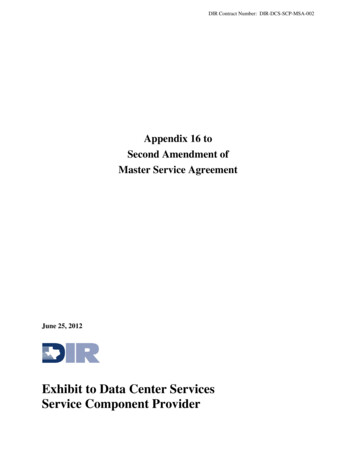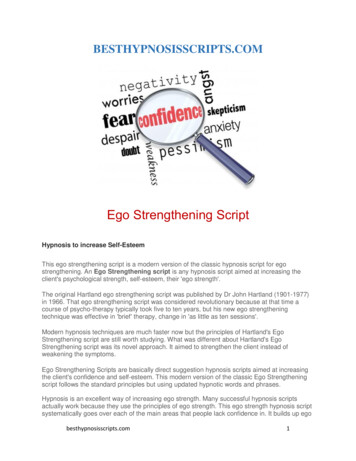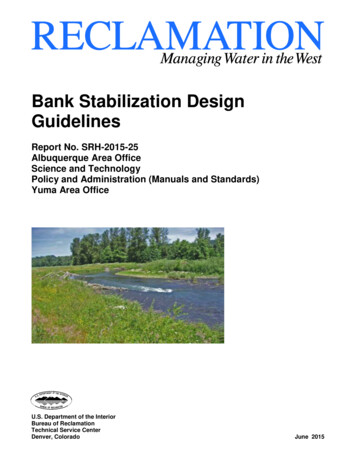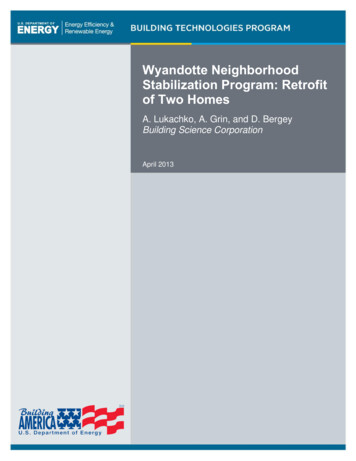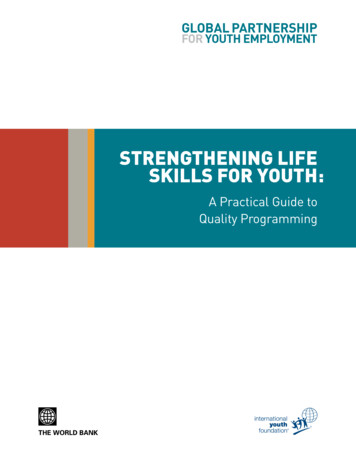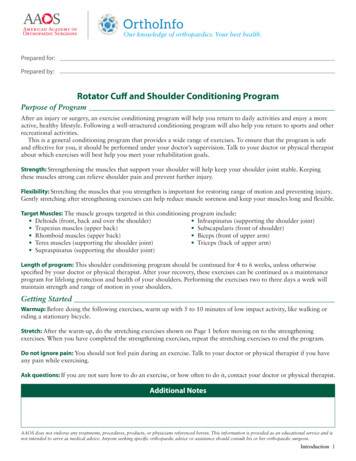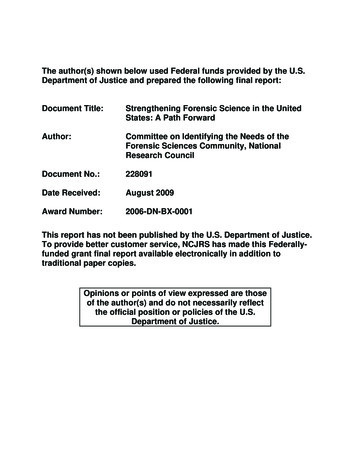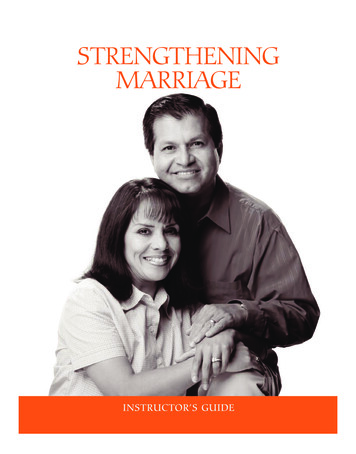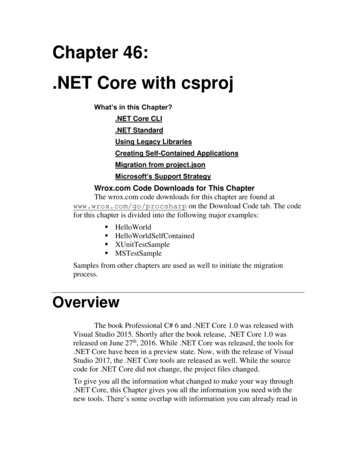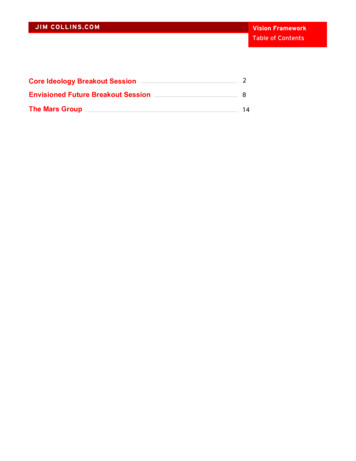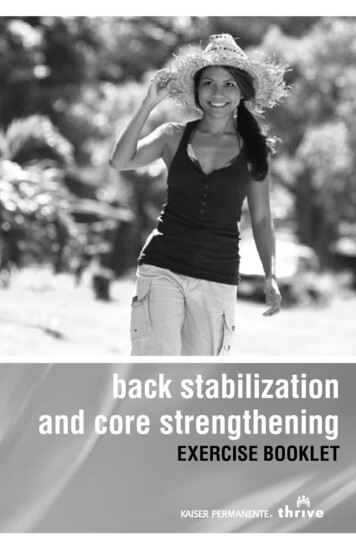
Transcription
back stabilizationand core strengtheningEXERCISE BOOKLET
back stabilization and core strengtheningTABLE OF CONTENTSIntroduction 1Hook-lying Stabilization Progression Neutral position2 Hook-lying with Arm Movements3 Bent Knee to Side4 Heel Slides5 Bent Knee Leg Lift (small steps)6 Alternate Arm and Leg Marching7 Curl-up8 Curl-up with Rotation9Hands and Knees Stabilization Progression Neutral Position10 Rocking Forward and Backward11 Arm Slide and Reach12 Leg Slide and Reach13 Opposite Arm and Leg Slide and Reach14Face-down Stabilization Progression Neutral Position15 Face-down One-arm Lift15 Face-down Knee Bend/Lift16 Face-down Arm/Leg Lift17Bridging Stabilization Progression Basic Bridge18 Bridge with Arm Lift18 Bridge with Leg Lift19Plank Exercises Side Support Plank20 Face-down Plank21
INTRODUCTIONThe deep muscles of your stomach and low back are the core muscles of your body. They support and protect your low back and alsohelp your leg and arm muscles work well. Doing the exercises in thisbooklet will strengthen your core muscles.Please read the instructions and follow the advice of your doctoror physical therapist when you start or progress to more difficultexercises.There are 4 basic starting positions: Hook-lying Face-down lying Hands and knees BridgeThe exercises get progressively more challenging in each position.Do not move to the next exercise in a series if you can’t do the onebefore it. If your symptoms get worse while doing these exercises,talk to your doctor or physical therapist.HEALTH EDUCATION1
Hook-lying Stabilization ProgressionNEUTRAL POSITIONLie on your back with your knees bent and your feet flat on thefloor, which is the “hook-lying” position.This is the starting position for the hook-lying exercises in thisseries. Find your neutral position by gently arching and flatteningyour back until you find a position where you are most comfortable.This is your neutral position. Gently tighten your stomach muscleswithout moving your back out of neutral position.2
Hook-lying Stabilization ProgressionHOOK-LYING WITH ARM MOVEMENTSLie on your back with your knees bent and arms by your sides.Find and hold your neutral position throughout the exercise.A. O ne arm: Lift one arm overhead slowly. Return it to the startposition while lifting the other arm overhead slowly. Continue byalternating right and left sides.AB. B oth arms: Lift both arms overhead and return slowly to thestart position while keeping your neutral position.BDo: AHEALTH EDUCATIONBFrequency3
Hook-lying Stabilization ProgressionBENT KNEE TO SIDEA. O ne knee bent: Lie on your back with one knee bent and theother leg straight. Find and hold your neutral position throughout the exercise. Slowly let your bent knee move out to the sidewithout moving your other hip.AB. B oth knees bent: Progress by doing the same exercise withboth knees bent. Continue by alternating right and left sides.BDo: A4BFrequency
Hook-lying Stabilization ProgressionHEEL SLIDESLie on your back with your knees bent and your feet flat on thefloor. Find and hold your neutral position throughout the exercise.A. H eel slide: Keep your heel on the ground and slowly slide yourfoot forward until your leg is almost straight. Return to the startposition by sliding your heel back. Repeat the movement withyour other leg.AB. H eel lift and slide: Repeat exercise A with your heel lifted 1 to 2inches from the floor. Continue by alternating right and left sides.BSTARTFINISHDo: AHEALTH EDUCATIONBFrequency5
Hook-lying Stabilization ProgressionBENT KNEE LEG LIFT (SMALL STEPS)Lie on your back with your knees bent and your feet flat on thefloor. Find and hold your neutral position throughout the exercise.A. O ne leg: Slowly lift one foot about 3 to 5 inches from the floor.Lower slowly. Repeat with the other foot and continue alternating legs as if taking small steps.AB. B oth legs: Slowly lift one foot about 3 to 5 inches from thefloor. Hold that position as you bring your other foot up. Slowlylower one leg, then the other. Continue this pattern: lift, lift,lower, lower.BDo: A6BFrequency
Hook-lying Stabilization ProgressionALTERNATE ARM AND LEG LIFTLie on your back with your knees bent and your feet flat on thefloor. Find and hold your neutral position throughout the exercise.Slowly lift one arm overhead and lift your opposite foot 3 to 5inches up from the floor. Slowly lower your arm and foot back tothe floor. Repeat with your other arm and leg. Continue to alternatesides.FrequencySTARTFINISHHEALTH EDUCATION7
Hook-lying Stabilization ProgressionCURL-UPLie on your back with your knees bent and your feet flat on thefloor. Find and hold your neutral position throughout the exercise.Do not do this exercise if you have osteoporosis (thinning bones).A. H ands on thigh: Place your hands on your thighs. Gently tighten your stomach muscles. Slowly lift your shoulders as you slideyour hands toward your knees. Keep your neck muscles relaxedby holding your chin tucked in. Return to the start position.AB. H ands behind head: Place your hands behind your head. Gentlytighten your stomach muscles. Slowly lift your shoulders up fromthe floor. Support your neck with your hands but do not pull onyour head. Return to the start position.BDo: A8BFrequency
Hook-lying Stabilization ProgressionCURL-UP WITH ROTATIONLie on your back with your knees bent and your feet flat on thefloor. Find and hold your neutral position throughout the exercise.Do not do this exercise if you have osteoporosis (thinning bones).A. O ne hand behind head: Place one hand behind your head.Gently tighten your stomach muscles. Lift your shoulder andreach with your free hand toward the opposite knee.AB. B oth hands behind head: Place both hands behind your head.Gently tighten your stomach muscles. Lift one shoulder andbring it toward the opposite knee. Support your neck with yourhands but do not pull on your head. Return to the start position.BDo: AHEALTH EDUCATIONBFrequency9
Hook-lying Stabilization ProgressionNEUTRAL POSITIONThis is the starting position for the hands and knees exercises in thisseries. Get on your hands and knees. Your hands should be directlybelow your shoulders and your knees should be directly below yourhips. Find your neutral position by gently moving your back up anddown until you find the most comfortable position. Gently tightenyour stomach muscles to hold your neutral position.10
Hands and Knees Stabilization ProgressionROCKING FORWARD AND BACKWARDStart on your hands and knees. Find and hold your neutral positionthroughout the exercise.A. R ocking forward: Slowly move your body forward over yourhands and then slowly return to the start position.AB. R ocking backward: Slowly move your body backward over yourheels and then slowly return to the start position.BC. R ocking forward and backward: Combine exercise A and B bymoving forward and backward in one smooth movement whilemaintaining your neutral position.Do: ABCFrequencyHEALTH EDUCATION11
Hands and Knees Stabilization ProgressionARM SLIDE AND REACHStart on your hands and knees. Find and hold your neutral positionthroughout the exercise.A. A rm slide: Slowly slide one hand forward on the floor and thenback to the start position. Repeat with your other side.B. A rm reach: Lift one arm and reach forward. Slowly loweryour arm to the start position. Repeat with the other arm,alternating sides.Do: A12BFrequency
Hands and Knees Stabilization ProgressionLEG SLIDE AND REACHStart on your hands and knees. Find and hold your neutral positionthroughout the exercise.A. L eg slide: Slide one leg back, keeping your toes on the floor. Return tothe start position. Repeat with theother leg. Alternate sides.AB. L eg lift—bent knee: Lift one leg 3 to5 inches from the floor with your kneebent. Slowly lower leg to the startposition. Repeat with the other leg.Continue alternating sides.C. L eg reach: Slide one leg backwarduntil the knee is straight. Lift yourstraight leg 3 to 5 inches from thefloor. Slowly lower to the start position. Repeat with the other leg.Continue alternatingDo: ABBCCFrequencyHEALTH EDUCATION13
Hands and Knees Stabilization ProgressionOPPOSITE ARM AND LEG SLIDE AND REACHStart on your hands and knees. Find and hold your neutral positionthroughout the exercise.A. A rm and leg slide: Slowly slide oneleg backward keeping your toes onthe floor. Slide your opposite armforward at the same time. Return tothe start position. Repeat with theother leg and arm. Continue alternating sides.B. A rm slide with bent knee lift: Slowlylift one leg keeping your knee bent.Slide your opposite hand forward atthe same time. Return to the start position. Repeat with the other leg andarm. Continue alternating sides.ABC. A rm and leg reach: Slowly slide oneleg backward keeping your toes onthe floor. Lift your foot 3 to 5 inchesfrom the floor. At the same time, slideyour opposite arm forward and lift 3Cto 5 inches from the floor. Return tothe start position. Repeat with theother leg and arm. Continue alternating sides.Do: AFrequency14BC
Face-down Stabilization ProgressionNEUTRAL POSITIONThis is the starting position for the face-down stabilization exercisesin this series. Lie on your stomach with your forehead resting on asmall towel. Add a pillow under your stomach if it makes you morecomfortable. Tighten your buttock muscles. This is your neutralposition. You may feel a slight stretch in the front of your hips.FACE-DOWN ONE-ARM LIFTStart in the neutral position lying face down. Hold throughout theexercise. Stretch both arms above your head. With your thumb up,lift one arm 1-3 inches from the floor. Return to the start positionand alternate arms.FrequencyHEALTH EDUCATION15
Face-down Stabilization ProgressionFACE-DOWN KNEE BEND/LIFTStart in the neutral position lying face down. Hold throughout theexercise.A. K nee bend: Bend one knee and then slowly lower your leg tothe starting position. Repeat exercise with the other leg. Continue to alternate sides.AB. K nee bend and lift: Bend one knee. Tighten your buttocksmuscles and lift your bent knee about 1 to 2 inches. Do not letyour back move or arch. You may need a pillow under your hipsto be able to do this exercise with good form. Hold for 5 seconds, and then lower your leg slowly to the start position. Repeatexercise with your other leg.BDo: A16BFrequency
Face-down Stabilization ProgressionFACE-DOWN ARM/LEG LIFTStart in the neutral position lying face down. Hold throughout theexercise.A. L eg lift: Tighten your buttocks muscles and lift one straight leg1 to 2 inches off the floor. Do not let your back arch. You mayneed to place a pillow under your hips to be able to do this exercise with good form. Hold for 5 seconds. Lower your leg slowlyto the start position. Repeat exercise with your other leg.AB. A rm and leg lift: Tighten your buttocks muscles. Lift one armand your opposite leg 1 to 2 inches off the floor. Do not allowyour back to twist or arch. Hold for 5 seconds and then loweryour arm and leg to the start position. Repeat exercise with yourother arm and leg.BDo: AHEALTH EDUCATIONBFrequency17
Bridging Stabilization ProgressionBASIC BRIDGEThis is the starting position for the bridge stabilization exercises inthis series. Lie on your back with your knees bent and feet flat onthe floor, hands by your sides. Gently tighten your stomach muscles. Lift your hips 3-5 inches from the floor without arching yourback. Hold bridge forseconds, and then slowly lower yourhips to the floor.FrequencySTARTFINISHBRIDGE WITH ARM LIFTStart with a Basic Bridge and maintain this position throughout theexercise.A. One arm lift: Hold the bridgeposition and move one armoverhead and back to your side.Alternate your arms, continuing tohold the bridge.AB. Both arms lift: Hold the bridgeposition and move both arms overhead and back to your sides.Do: AFrequency18BB
Bridging Stabilization ProgressionBRIDGE WITH LEG LIFTStart with a Basic Bridge and maintain this position throughoutthe exercise.A. H eel lift: Lift one heel up keepingyour toes on the floor. Slowly loweryour heel to the floor. Repeat on theother side. Continue alternating whileholding the bridge.AB. Marching: Lift one foot 3 to 5 inches,keeping your knee bent. Slowly loweryour foot to the floor and repeat withthe other side. Continue alternating asif marching in place.BC. L eg lifts: lift one leg with your kneebent, and then straighten your knee.Hold seconds. Slowly bend yourknee and lower your leg, returning tothe Basic Bridge position. Repeat themovement with the other leg. Continue alternating sides while holding thebridge.Do: ABCCFrequencyHEALTH EDUCATION19
Plank ExercisesSIDE SUPPORT PLANKA. O n knees: Lie on one side with both of your knees bent andyour hips in line with your shoulders. Support your weight onyour forearm with your elbowdirectly under your shoulder.Rest your top hand on yourhip. Tighten your stomach andbuttocks muscles and keepthem tight throughout the exercise. Lift your hips 3-4 inches Afrom the floor. Holdseconds. Slowly lower to thestart position.FrequencyProgress to holdingsecondsB. On Feet. Lie on your side with your knees, hips, and shouldersin line. Rest your top hand on your hip. Tighten your stomachand buttocks muscles andkeep them tight throughoutthe exercise. Lift your hips 3-4inches from the floor. Keepyour knees straight during thisexercise. HoldsecBonds. Slowly lower to the startposition.FrequencyProgress to holding20seconds
Plank ExercisesFACE-DOWN PLANKA. O n knees: Lie face down with your weight supported on yourforearms and knees. Make sure your elbows are directly underyour shoulders. You may cross your ankles. Tighten your stomach and buttocks muscles and keep them tight throughout theexercise.Holdseconds.AFrequencyProgress to holdingsecondsB. O n feet: Lie face down with your weight supported on yourtoes and forearms. Tighten your stomach and buttocks musclesand keep them tight throughout the exercise. Do not let yourback sag. Holdseconds. Slowly lower your knees to theground.BFrequencyProgress to holdingHEALTH EDUCATIONseconds21
This information is not intended to diagnose health problems or to take the place ofmedical advice or care you receive from your physician or other health care professional.If you have persistent health problems, or if you have additional questions, please consultwith your doctor. 2014, The Permanente Medical Group, Inc. All rights reserved. Regional Health Education andPhysical Therapy.9134000107 (Revised 4/14) RL 4.5
or physical therapist when you start or progress to more difficult exercises. There are 4 basic starting positions: Hook-lying Face-down lying Hands and knees Bridge The exercises get progressively more challenging in each position. Do not move to the nex

